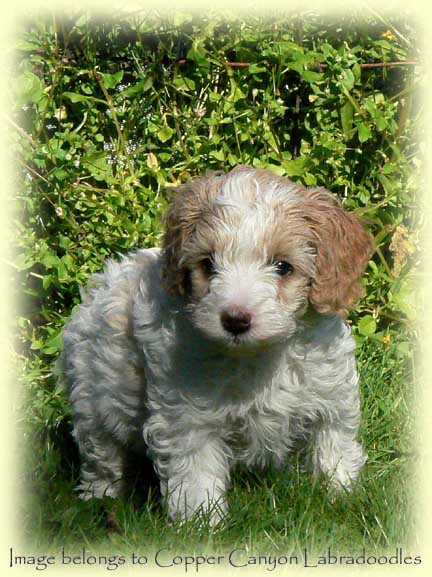When the original founders of the breed set out to create the Australian Labradoodle, they began with a number of early generation labradoodles from the Royal Gude Dog Association as well as from a breeder named Don Evans. These dogs were of various generations from F1 (first crossing between a lab and a poodle) and higher, likely F1B’s ( an F1 crossed back to a poodle) and F2’s ( puppies from two F1 parents), etc. Angela Cunningham of Tegan Park was the first developer of the Australian Labradoodle and was later joined by her mother, Beverly Manners, in continuing to develop the Australian Labradoodles as an emerging new breed. The two breeding centers sometimes worked together and other times, not.
In that process, a breed type and breed standard were written and then various other breeds of dogs were bred in and the resulting progeny observed to see if they aided the process and were a good contribution to Angela’s vision of what an Australian Labradoodle should be or not. Lines of Labradoodles that were seen to be of benefit were retained and other lines were spayed/neutered and not continued with. Angela’s goal was to create a sturdy, medium boned dog with an easy-care non shedding coat and an friendly, easy going nature that would be suitable for therapy work and assistance dog work.
While we may never know all the various breeds that were tried in the early days, it is certainly known that the English and American Cocker Spaniel contributed to the breed, and cockapoos of various generations were bred into existing lines of Australian Labradoodles. They contributed a stockier body type as well as shortening the muzzle and gave a pleasing shape to the head. Low ear set and excessive doming of the head were and are to be bred away from. The Irish Water Spaniel was also used as was the Curly Coated Retriever. Both breeds introduced the chocolate colour into the breed. The open faces of both breeds and the hairless “rat tail” of the Irish Water Spaniel are to be bred away from as well as any aloofness sometimes found in the IWS breed.
During the time while both Tegan Park and Rutland Manor were members of the Labradoodle Association, a development plan was drafted delineating how the breed was to be developed and how to achieve “pure” status. This has gone through a few revisions and most of this is “breeder talk” but the basics are as follows:
- Any Labradoodle with breed heritage including these other parent breeds in its’ ancestry is called an Australian Labradoodle.
- An Australian Labradoodle bred with another Australian Labradoodle may be called a “multigen”.
- Any Labradoodle with only lab/poodle in its’ pedigree is not an Australian Labradoodle and they are generally being called American Labradoodles or “early gens”
- Australian Labradoodles and American Labradoodles may be bred together and the offspring will be called Australian
- Labradoodles but not “multigen”. However, those dogs may be bred to another Australian Labradoodle and the resulting puppies will be classed as “multigen”.
There are restrictions as to how many times poodles or other parent breeds may be infused into the lines as follows:
Poodles may be bred in twice consecutively at the very beginning to set coat type. After that, Poodle may be bred in up to twice more but not consecutively and frequent use of Poodle is not encouraged.
Other parent breeds may be bred in only once within six generations on any one side of the pedigree. No further additions of that breed are permitted.
Generation counting is to be one more than the lowest generation of Labradoodle or Australian Labradoodle used. So for instance, if one crosses an F2 with an F5, the puppies are classed as F3’s.
Initially, one could advance a generation with a poodle mating but have it designated “pp” for parent Poodle. Currently, this remains the case in Australia and in America, the generation count would be reset to an earlier generation.
Once there have been six consecutive matings of Australian Labradoodles (following the scheme for advancement), the dog may be classed as PAL for “pure” Australian labradoodle.
The focus of this process is to breed towards the breed standard and so good evaluation skills of the dogs in the breeding program is important! Temperament and health are key components and if the dog fails basic genetic testing or has poor temperament (dominant, timid, etc) it is not acceptable in a breeding program. One tries to choose matings that will produce an exceptional example of the Australian Labradoodle breed. For instance, if one has a female that has passed testing, has lovely temperament and good coat but lacks in width, then a suitable stud choice would be a very widely built male with good boning.
The Australian Labradoodle Association of America (ALAA) has a continuing interest in working with the Australian Labradoodle Association (ALA) and other sister organizations under the umbrella of the International Labradoodle Association (ILA) to guide and develop this lovely emerging breed of dog. For genetic health and diversity, it is seen as important to carefully develop new lines of Australian Labradoodles as the gene pool, at this time, is still fairly closely related. And as many of the genetic issues plaguing the “pure breeds” are the result of a shrinking gene pool and too closely breeding related dogs together, these organizations see the need to continue to develop new bloodlines of Australian Labradoodles, following in the steps of the breed founder, Angela Cunningham of Tegan Park. These new lines are carefully developed and overseen by the breed club and will allow the Australian Labradoodle breed to continue to be a healthy, delightful family pet.
